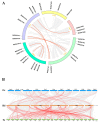Genome-Wide Characterization, Evolution, and Expression Profile Analysis of GATA Transcription Factors in Brachypodium distachyon
- PMID: 33670757
- PMCID: PMC7922913
- DOI: 10.3390/ijms22042026
Genome-Wide Characterization, Evolution, and Expression Profile Analysis of GATA Transcription Factors in Brachypodium distachyon
Abstract
The GATA proteins, functioning as transcription factors (TFs), are involved in multiple plant physiological and biochemical processes. In this study, 28 GATA TFs of Brachypodium distachyon (BdGATA) were systematically characterized via whole-genome analysis. BdGATA genes unevenly distribute on five chromosomes of B. distachyon and undergo purifying selection during the evolution process. The putative cis-acting regulatory elements and gene interaction network of BdGATA were found to be associated with hormones and defense responses. Noticeably, the expression profiles measured by quantitative real-time PCR indicated that BdGATA genes were sensitive to methyl jasmonate (MeJA) and salicylic acid (SA) treatment, and 10 of them responded to invasion of the fungal pathogen Magnaporthe oryzae, which causes rice blast disease. Genome-wide characterization, evolution, and expression profile analysis of BdGATA genes can open new avenues for uncovering the functions of the GATA genes family in plants and further improve the knowledge of cellular signaling in plant defense.
Keywords: Brachypodium distachyon; GATA transcription factors; genome-wide characterization; phylogenetic analysis; profile analysis.
Conflict of interest statement
The authors declare no conflict of interest.
Figures








Similar articles
-
Genome-Wide Analysis and Expression Profiles of the MYB Genes in Brachypodium distachyon.Plant Cell Physiol. 2017 Oct 1;58(10):1777-1788. doi: 10.1093/pcp/pcx115. Plant Cell Physiol. 2017. PMID: 29016897
-
Genome-wide exploration of the molecular evolution and regulatory network of mitogen-activated protein kinase cascades upon multiple stresses in Brachypodium distachyon.BMC Genomics. 2015 Mar 24;16(1):228. doi: 10.1186/s12864-015-1452-1. BMC Genomics. 2015. PMID: 25886731 Free PMC article.
-
Genome-wide identification and analysis of MAPK and MAPKK gene families in Brachypodium distachyon.PLoS One. 2012;7(10):e46744. doi: 10.1371/journal.pone.0046744. Epub 2012 Oct 17. PLoS One. 2012. PMID: 23082129 Free PMC article.
-
Brachypodium: A Monocot Grass Model Genus for Plant Biology.Plant Cell. 2018 Aug;30(8):1673-1694. doi: 10.1105/tpc.18.00083. Epub 2018 Jul 11. Plant Cell. 2018. PMID: 29997238 Free PMC article. Review.
-
Plant GATA Factors: Their Biology, Phylogeny, and Phylogenomics.Annu Rev Plant Biol. 2022 May 20;73:123-148. doi: 10.1146/annurev-arplant-072221-092913. Epub 2022 Feb 7. Annu Rev Plant Biol. 2022. PMID: 35130446 Review.
Cited by
-
Investigating the Role of OsHDT701 and Other Blast-Associated Negative Regulatory Genes in Indica Rice Cultivar Ranjit Using Combined Wet Lab and Computational Approaches.Mol Biotechnol. 2024 Oct 30. doi: 10.1007/s12033-024-01310-7. Online ahead of print. Mol Biotechnol. 2024. PMID: 39476286
-
Heat responsive gene StGATA2 functions in plant growth, photosynthesis and antioxidant defense under heat stress conditions.Front Plant Sci. 2023 Jul 11;14:1227526. doi: 10.3389/fpls.2023.1227526. eCollection 2023. Front Plant Sci. 2023. PMID: 37496854 Free PMC article.
-
Genome-Wide Identification of the Eucalyptus urophylla GATA Gene Family and Its Diverse Roles in Chlorophyll Biosynthesis.Int J Mol Sci. 2022 May 8;23(9):5251. doi: 10.3390/ijms23095251. Int J Mol Sci. 2022. PMID: 35563644 Free PMC article.
-
Comprehensive Comparative Analysis of the GATA Transcription Factors in Four Rosaceae Species and Phytohormonal Response in Chinese Pear (Pyrus bretschneideri) Fruit.Int J Mol Sci. 2021 Nov 19;22(22):12492. doi: 10.3390/ijms222212492. Int J Mol Sci. 2021. PMID: 34830372 Free PMC article.
-
Integrated Analysis of MicroRNA and Target Genes in Brachypodium distachyon Infected by Magnaporthe oryzae by Small RNA and Degradome Sequencing.Front Plant Sci. 2021 Oct 1;12:742347. doi: 10.3389/fpls.2021.742347. eCollection 2021. Front Plant Sci. 2021. PMID: 34659311 Free PMC article.
References
-
- Zhang C., Hou Y., Hao Q., Chen H., Chen L., Yuan S., Shan Z., Zhang X., Yang Z., Qiu D., et al. Genome-Wide Survey of the Soybean GATA Transcription Factor Gene Family and Expression Analysis under Low Nitrogen Stress. PLoS ONE. 2015;10:e0125174. doi: 10.1371/journal.pone.0125174. - DOI - PMC - PubMed
MeSH terms
Substances
Supplementary concepts
Grants and funding
- 31801721; 31672017/National Natural Science Foundation of China
- 2016YFD0200800; 2016YFD0300707/National Key Research and Development Project
- 2020JJ5240/the Natural Science Foundation of Hunan Province, China
- 19B247/the Scientific Research Fund of Hunan Provincial Education Department
- 19QN31/the Youth Fund Project of Hunan Agricultural University
LinkOut - more resources
Full Text Sources
Other Literature Sources
Research Materials

